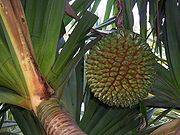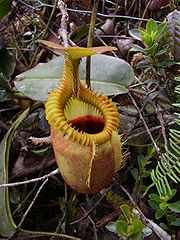
Paleotropical Kingdom
Encyclopedia



Africa
Africa is the world's second largest and second most populous continent, after Asia. At about 30.2 million km² including adjacent islands, it covers 6% of the Earth's total surface area and 20.4% of the total land area...
, Asia
Asia
Asia is the world's largest and most populous continent, located primarily in the eastern and northern hemispheres. It covers 8.7% of the Earth's total surface area and with approximately 3.879 billion people, it hosts 60% of the world's current human population...
and Oceania
Oceania
Oceania is a region centered on the islands of the tropical Pacific Ocean. Conceptions of what constitutes Oceania range from the coral atolls and volcanic islands of the South Pacific to the entire insular region between Asia and the Americas, including Australasia and the Malay Archipelago...
(including Australia
Australia
Australia , officially the Commonwealth of Australia, is a country in the Southern Hemisphere comprising the mainland of the Australian continent, the island of Tasmania, and numerous smaller islands in the Indian and Pacific Oceans. It is the world's sixth-largest country by total area...
), as proposed by Ronald Good and Armen Takhtajan
Armen Takhtajan
Armen Leonovich Takhtajan or Takhtajian , was a Soviet-Armenian botanist, one of the most important figures in 20th century plant evolution and systematics and biogeography. His other interests included morphology of flowering plants, paleobotany, and the flora of the Caucasus...
. Its flora
Flora
Flora is the plant life occurring in a particular region or time, generally the naturally occurring or indigenous—native plant life. The corresponding term for animals is fauna.-Etymology:...
is characterized by about 40 endemic plant families
Family (biology)
In biological classification, family is* a taxonomic rank. Other well-known ranks are life, domain, kingdom, phylum, class, order, genus, and species, with family fitting between order and genus. As for the other well-known ranks, there is the option of an immediately lower rank, indicated by the...
, e.g. Nepenthaceae, Musaceae
Musaceae
Musaceae is a botanical name for a family of flowering plants. The family is native to the tropics of Africa and Asia. The plants have a large herbaceous growth habit with leaves with overlapping basal sheaths that form a pseudostem making some members appear to be woody trees.The family has been...
, Pandanaceae
Pandanaceae
Pandanaceae is a family of flowering plants native to the tropics of the Old World. Such a family has been widely recognized by taxonomists.Pandanaceae are trees or climbing or scrambling shrubs distributed in the Old World tropics and are adapted from sea level in salted beaches to mountain cloud...
, Flagellariaceae
Flagellariaceae
Flagellariaceae is the botanical name for a family of flowering plants. Such a family has rarely been recognized by taxonomists.The APG II system, of 2003 , does recognize such a family, and assigns it to the order Poales in the clade commelinids, in the monocots...
. Part of its flora, inherited from the ancient supercontinent of Gondwana
Gondwana
In paleogeography, Gondwana , originally Gondwanaland, was the southernmost of two supercontinents that later became parts of the Pangaea supercontinent. It existed from approximately 510 to 180 million years ago . Gondwana is believed to have sutured between ca. 570 and 510 Mya,...
or exchanged later (e.g. Piperaceae
Piperaceae
The Piperaceae, also known as the pepper family, is a large family of flowering plants. The group contains roughly 3,610 currently accepted species in five genera. The vast majority of peppers can be found within the two main genera: Piper and Peperomia .Members of the Piperaceae may be small...
with pantropical distribution and but few warm temperate representatives), is shared with the Neotropical Kingdom, comprising tropical areas of Central
Central America
Central America is the central geographic region of the Americas. It is the southernmost, isthmian portion of the North American continent, which connects with South America on the southeast. When considered part of the unified continental model, it is considered a subcontinent...
and South America
South America
South America is a continent situated in the Western Hemisphere, mostly in the Southern Hemisphere, with a relatively small portion in the Northern Hemisphere. The continent is also considered a subcontinent of the Americas. It is bordered on the west by the Pacific Ocean and on the north and east...
. Moreover, the Paleotropical flora influenced the tropical flora of the Australian Kingdom. The Paleotropical Kingdom is subdivided into five floristic subkingdoms according to Takhtajan (or three, according to Good) and about 13 floristic regions. In this article the floristic subkingdoms and regions are given as delineated by Takhtajan.
African Subkingdom
10 endemic families (incl. DioncophyllaceaeDioncophyllaceae
Dioncophyllaceae is a family of flowering plants consisting of three species of lianas native to the rainforests of western Africa.Its closest relative is Ancistrocladaceae. Both of these families lie within a clade of mostly carnivorous plants which since 1998 or so have been moved to the order...
, Pentadiplandraceae, Scytopetalaceae, Medusandraceae
Medusandraceae
Medusandra is a genus of flowering plants in the family Peridiscaceae. It has two species, Medusandra richardsiana and Medusandra mpomiana. M. richardsiana is the most common and well known. Both species are native to Cameroon and adjacent countries. Medusandra was named by John Brenan in 1952...
, Dirachmaceae, Kirkiaceae
Kirkiaceae
Kirkiaceae is a family of flowering plant in the order Sapindales. It comprises two genera, Kirkia and Pleikirkia, totalling six species...
), many endemic genera.
- Guineo-Congolian Province
- Usambara-Zululand Region
- Sudano-Zambezian Region (including tropical Asia west of the Gulf of KhambhatGulf of KhambhatThe Gulf of Khambhat is an inlet of the Arabian Sea along the west coast of India, in the state of Gujarat. It is about 80 miles in length, and divides the Kathiawar peninsula to the west from the eastern part of Gujarat state on the east. The Narmada and Tapti rivers empty into the Gulf...
) - Karoo-Namib Region
- St. Helena and Ascension Region
Madagascan Subkingdom
9 endemic families, more than 450 endemic genera, about 80% endemic species. It ceased to be influenced by the African flora in the CretaceousCretaceous
The Cretaceous , derived from the Latin "creta" , usually abbreviated K for its German translation Kreide , is a geologic period and system from circa to million years ago. In the geologic timescale, the Cretaceous follows the Jurassic period and is followed by the Paleogene period of the...
, but underwent heavy influence of the Indian Region's flora.
- Madagascan Region
Indo-Malesian Subkingdom
11 endemic families (incl. DegeneriaceaeDegeneriaceae
Degeneriaceae is the botanical name for a family of flowering plants. Such a family has been recognised by more than a few taxonomists, at least over the past few decades....
, Barclayaceae, Mastixiaceae) and many endemic genera
- Indian Region
- Indochinese Region
- Malesian Region
- Fijian Region
Polynesian Subkingdom
No endemic families, many endemic genera. The flora is mostly derivative from that of the Indo-Malesian Subkingdom.- Polynesian Region
- Hawaiian Region
Neocaledonian Subkingdom
Several endemic families (incl. AmborellaceaeAmborellaceae
Amborella is a genus of rare understory shrubs or small trees endemic to the island of New Caledonia. The genus consists of only a single species, Amborella trichopoda, and is the only member of the family Amborellaceae. Wood of Amborella lacks the vessels characteristic of most flowering plants...
, Strasburgeriaceae) and more than 130 endemic genera (incl. Exospermum and Zygogynum
Zygogynum
Zygogynum is a genus of plant in family Winteraceae. All species are native to New Caledonia, and are pollinated primarily by beetles and moths.The genus contains the following species :...
). The flora is partially shared with the Indo-Malesian Subkingdom and the Australian Kingdom.
- Neocaledonian Region
See also
- Flora of the Coral Sea IslandsFlora of the Coral Sea IslandsThe Flora of the Coral Sea Islands consists of 16 families, 24 genera and 26 species. Five of these species are introduced and naturalised. The vegetation is mostly herbfields, although a few islands support shrubs and low forests.....
- Flora of IndiaFlora of IndiaThe Flora of India is one of the richest of the world due to a wide range of climate, topology and environments in the country. It is thought there are over 15000 species of flowering plants in India,which account for 6 percent of the total plant species in the world. and probably many more species...
- Flora of IndonesiaFlora of IndonesiaThe flora of Indonesia consists of many unique varieties of tropical plants. Blessed with a tropical climate and around 18,000 islands, Indonesia is a nation with the second largest biodiversity in the world. The flora of Indonesia reflects an intermingling of Asian, Australian and the native species...
- Flora of the Marquesas IslandsFlora of the Marquesas IslandsThe Marquesas Islands have a diverse flora, with a high rate of endemism. They are in the floristic Polynesian subkingdom of the Oceania ecozone.-Food Plants:Most of the food plants are not endemic, and include:*Avocados*Bananas...
- Flora of St HelenaFlora of St HelenaThe flora of Saint Helena, an isolated island in the South Atlantic Ocean, is exceptional in its high level of endemism and the severe threats facing the survival of the flora. In phytogeography, it is in the phytochorion St...

